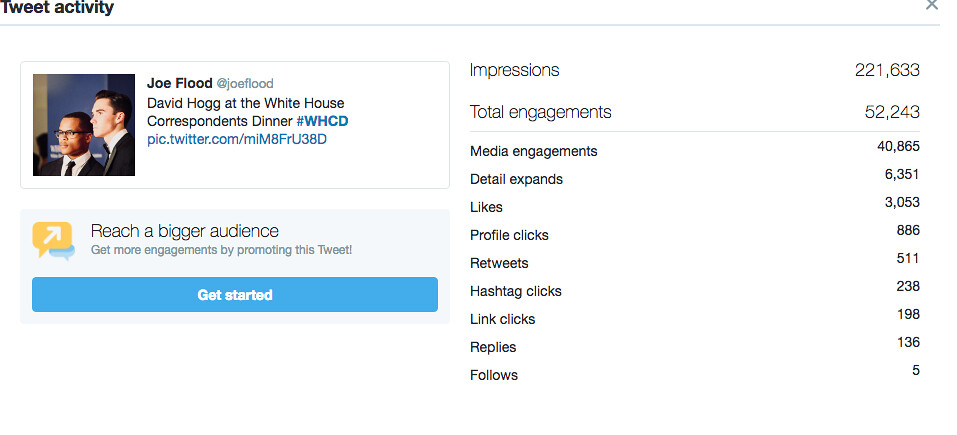A viral photo became my most popular tweet ever, racking up more than 200,000 impressions.
It’s a picture that I captured outside the White House Correspondents Dinner, a quick shot of Parkland survivor David Hogg before I was shooed away by security. Happy to get any photo, I posted it to Twitter, thinking my photographer friends would enjoy it.
And then it blew up online, my phone steadily buzzing with notifications through the night and for days afterward.
What can you learn from going viral?
- It will be accidental. It’s nice to think that you can make a post go viral – you can’t. Twitter is driven by the users. Their likes, dislikes, passions, prejudices and whims determine what goes viral and what doesn’t. I’ve written funnier tweets, taken better photos and shared more interesting links but it was this post of David Hogg that went viral, for it was timely (the dinner was going on as I posted the photo) and Hogg is a controversial figure in the gun control debate.
- You’ll want to change your tweet. In my photo, another person is pictured. I didn’t recognize him so just identified David Hogg. Within minutes, a reply told me that it was Zion Kelly, whose brother was shot to death on the streets of DC. You can’t edit a tweet so I added a threaded post identifying him.
- You will be personally attacked. I didn’t reply to the gun nuts who thought that the presence of David Hogg at the WHCD was preposterous. But a couple people said that I was racist for omitting mention of Zion Kelly in my original tweet. When I explained to one that I didn’t recognize him, she grudgingly admitted that I might not be a racist but my response was “problematic.”
- You won’t understand the analytics. My original tweet had 221,000 impressions. The thread I added with Zion Kelly’s name had 680,000 impressions. Why does the thread have more than the original?
- It won’t amount to much. Seeing the photo go viral, I wrote a post the next day on the moment, which captured some of the traffic my photo generated. But out of 220,000 Twitter impressions, I gained five new followers. The raging discourse of America had landed briefly on me, lit me in its fire, and then moved on to the next topic in the endless, infernal debate.
Going viral is short-lived and unsatisfying. All that storm und drang around my photo ultimately amounted to little.
.@DCDOTRA taking back the streets one block at a time #bikedc pic.twitter.com/jJls8g0e4E
— Joe Flood (@joeflood) April 29, 2018
The next morning, I bundled up and biked to see my friends from the District Department of Transformation, a group of activists trying to make the city’s streets safer. They’re all people I’ve met through Twitter. They had blocked off a street for breakfast, an action designed to show that streets should be for people, not cars.
I took a photo and shared it using the #BikeDC hashtag.
That’s the type of engagement that matters – real, small-scale and committed.
If you’re a social media manager, don’t chase social media fame, which is ephemeral and low-value. Instead, use Twitter to build an impactful community of engaged supporters, people who will show up for you on a cold Sunday morning to occupy a street.
